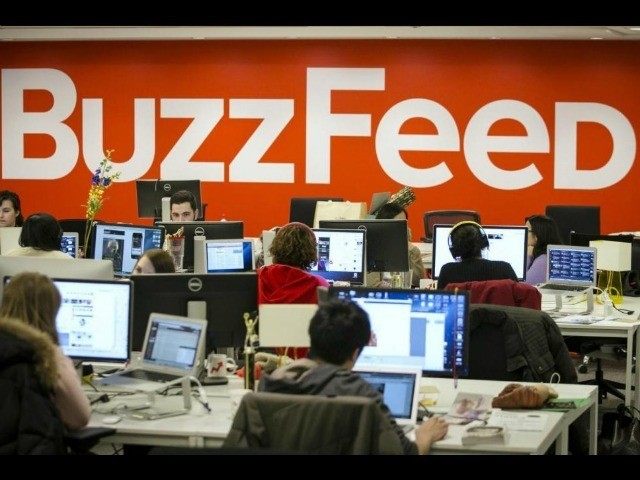It was reported this week that BuzzFeed has slashed its 2016 revenue forecast in half, after missing its 2015 target by more than $80 million.
Revelations of financial pain at the clickbait empire — long seen as the most successful millennial-oriented new media property — is just the latest in a string of bad news for left-wing new media. From Gawker to Salon to the Huffington Post, they all seem to be in trouble.
According to the Financial Times (paywalled), BuzzFeed missed its revenue target by approximately 32 percent in 2015, making less than $170 million against a target of $250 million. It would seem that articles like “18 Cats Who Are Beyond Pumped For Taylor Swift’s New Album” might not have been as popular as investors thought.
But BuzzFeed is not alone. Salon.com, known for publishing articles so absurdly left-wing that their headlines are sometimes difficult to differentiate from its well-known parody Twitter account, was recently forced to lay off six long-time staffers, including Assistant Managing Editor Ruth Henrich and Life Editor Kim Brooks. Salon CEO Cindy Jeffers later confirmed that the layoffs were due to budget cuts at the company.
Gawker, another formerly successful blog known for its left-wing slant, has of course been in trouble for some time. Even before the outcome of the Hulk Hogan sex tape trial, which saw the new media site slapped with an eye-watering fine of $140 million, Gawker was on the ropes. The site’s traffic stalled, and then started a precipitous decline in late 2015.
Then, last November, the site gutted its verticals, cutting seven full-time editorial positions and pivoting to a political editorial focus. Although Gawker reportedly has new financial backing — from Russian oligarchs, no less — the site is still in dire straits traffic-wise. In retrospect, perhaps destroying people’s careers for politically incorrect jokes on Twitter and pointlessly outing gay chief executives wasn’t the best way to appeal to a millennial audience.
We find a similar story when we look at other left-wing new media publications. The Huffington Post recently let go dozens of employees after suffering tanking traffic figures, while Demand Media recently sold its floundering left-wing comedy site Cracked.com to E.W. Scripps. “Demand has shrunk down to a company that’s running a handful of content sites with declining traffic and revenue,” Re/code bluntly explained. And then there’s The New Republic: once a respected, high-brow political magazine, the publication was recently sold after former owner Chris Hughes tried and failed to convert it into a BuzzFeed-like content factory.
In their ascendancy, many of these new media outlets left a trail of victims in their wake — many of whom are no doubt feeling a great sense of schadenfreude these days. Gawker in particular delighted in “outing” politically incorrect social media users to its devoted left-wing readers, who would typically respond by showering the individuals’ employers with complaints until they were fired.
Gawker’s victims included former Business Insider CTO Pax Dickinson and former marketing consultant Justine Sacco. Author and journalist Jon Ronson would eventually redefine Gawker’s tactics as a modern-day form of ritual public humiliation in his 2015 book So You’ve Been Publicly Shamed.
Eventually, Gawker’s attempts to position itself as inquisitors-in-chief of the web would backfire spectacularly. Their attempts to demonize the gaming community in 2014 cost them “six figures” in advertising revenue, after legions of gamers bombarded the site’s advertisers with complaints.
What about Vice Media? The company has attracted eye-watering sums of investment, recently closing a $200 million deal with Disney. Last year, its valuation rose to $4.5 billion, and it projected revenues of $1 billion. Yet this year it appears to be on course for disaster: its head of ad sales recently resigned after the site suffered a shocking 17.4 percent crash in traffic.
Vice’s vaunted efforts to move into TV have also proven a monumental disappointment. Viceland, its cable TV network, bombed on launch. Despite efforts by the company to suppress ratings data, the International Business Times discovered that its ratings were 77 percent lower than the channel it replaced. In raw numbers, Viceland received an average of just 60,400 viewers per day in its first week — fewer than many amateur YouTube channels.
Of the left-wing new media unicorns, only Vox Media seems to be in a stable condition, with 2016 traffic figures that are slightly higher than last year’s. Yet the it is still valued at an absurdly high sum of $1 billion, and the company has yet to release its 2015 revenue figures.
The golden age of the left-wing millennial media bubble appears to be drawing to a close. If Breitbart’s soaring traffic is anything to go by, the next generation of web users are demanding more substance behind headlines, fewer politically correct witch-hunts, and less barmy left-wing bias. Or they might just prefer our fonts.
You can follow Allum Bokhari on Twitter, add him on Facebook, and download Milo Alert! for Android to be kept up to date on his latest articles.

COMMENTS
Please let us know if you're having issues with commenting.